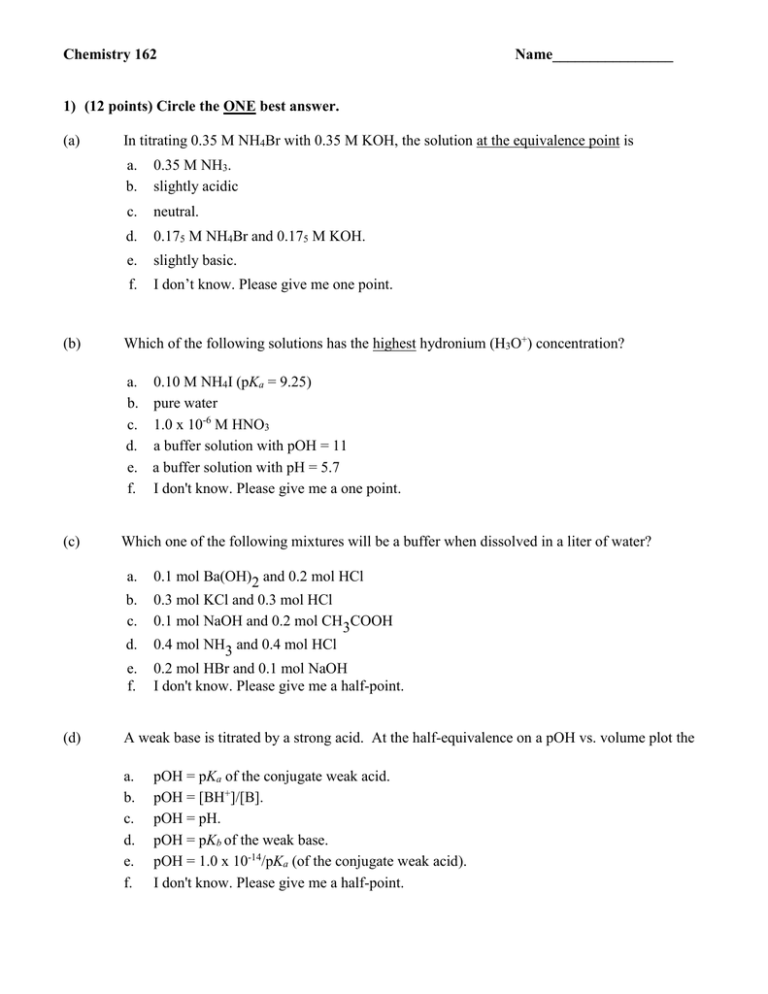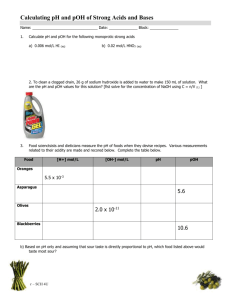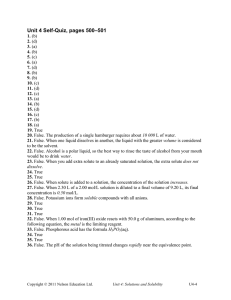blank test
advertisement

Chemistry 162 Name________________ 1) (12 points) Circle the ONE best answer. (a) (b) In titrating 0.35 M NH4Br with 0.35 M KOH, the solution at the equivalence point is a. b. 0.35 M NH3. slightly acidic c. neutral. d. 0.175 M NH4Br and 0.175 M KOH. e. slightly basic. f. I don’t know. Please give me one point. Which of the following solutions has the highest hydronium (H3O+) concentration? a. 0.10 M NH4I (pKa = 9.25) b. pure water c. 1.0 x 10-6 M HNO3 d. a buffer solution with pOH = 11 e. a buffer solution with pH = 5.7 f. I don't know. Please give me a one point. (c) (d) Which one of the following mixtures will be a buffer when dissolved in a liter of water? a. 0.1 mol Ba(OH)2 and 0.2 mol HCl b. c. 0.3 mol KCl and 0.3 mol HCl 0.1 mol NaOH and 0.2 mol CH3COOH d. 0.4 mol NH3 and 0.4 mol HCl e. f. 0.2 mol HBr and 0.1 mol NaOH I don't know. Please give me a half-point. A weak base is titrated by a strong acid. At the half-equivalence on a pOH vs. volume plot the a. b. c. d. e. f. pOH = pKa of the conjugate weak acid. pOH = [BH+]/[B]. pOH = pH. pOH = pKb of the weak base. pOH = 1.0 x 10-14/pKa (of the conjugate weak acid). I don't know. Please give me a half-point. 2) (6 points) Arrange the following 0.10 M solutions in order from most acidic to most basic: KOH, KCl, KCN, NH4Cl & HCl. most acidic most basic 3) (6 points) pH 1 pH pOH 2 volume volume 3 volume a) Which plot shows a strong acid being titrated by a strong base? _________ b) Which plot shows a weak base being titrated by a strong acid? _________ c) Which plot shows diprotic character? _________ 4) (10 points) Circle the… a) strongest acid HIO2 vs. HIO b) weakest base PH3 vs. PF3 c) most stable acid [CH3CH2CHBrNH3]+ vs. d) least stable base [CH2=CH-NH] - vs. [CH3CH2CH2NH3]+ [CH≡C-NH] - e) Explain ONLY ONE of the four comparisons (a, b, c, or d). In your explanation you should include one or more of following influences where appropriate: effective nuclear charge, electronegativity differences, charge density, bond polarization, bond strength, resonance delocalization, hybridization, or inductive effect. An explanation like “it is stronger because there are less oxygen …” is not acceptable by itself. 5) (20 points) An aqueous solution contains 2.00 g of formic acid (HCOOH, MW = 46.025 g/mol). The volume of the solution is 0.500 L. The pKa for formic acid is 3.74. Assume the temperature is constant during the time it takes to answer this question. a) Will this solution be acidic, basic, or neutral? b) Write the balanced equilibrium equation that describes this solution. Make sure to include the states of all species. c) Calculate the pH of this solution. d) If 1.00 g sodium formate (NaHCOO, MW = 68.007 g/mol) is dissolved in the solution in part c, what will be the pH of the resulting solution? Assume the volume is still 0.500 L. e) If 0.20 g of NaOH is added to the solution, what is the pH of the resulting solution? f) Does your answer make sense based on Le Chatelier's Principle? Explain your reasoning. 6) (6 points) Given the following table of equilibrium constants at 25°C. H2PO4– + H+ H3PO4 1.4 x 102 H+ + PO43– HPO42– 2.1 x 1012 H2PO4– HPO42– + H+ 6.2 x 10–8 a. Calculate the equilibrium constant for the following equation: H3PO4 + 3H2O 3H3O+ + PO43– b. Explain the resulting equilibrium constant. What does it mean for this reaction based on the value and the chemical changes? c. What would be the relative pH value of a solution made by dissolving K3PO4 in water? Explain.





